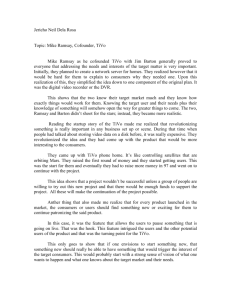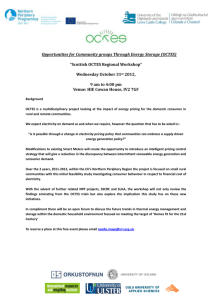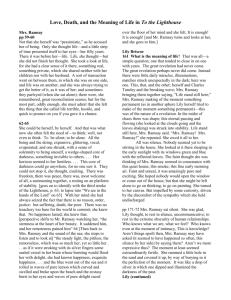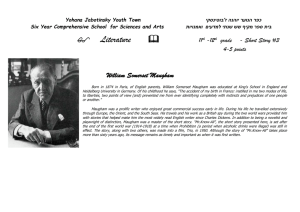Quality Accounts Extraordinary care needs extraordinary people
advertisement
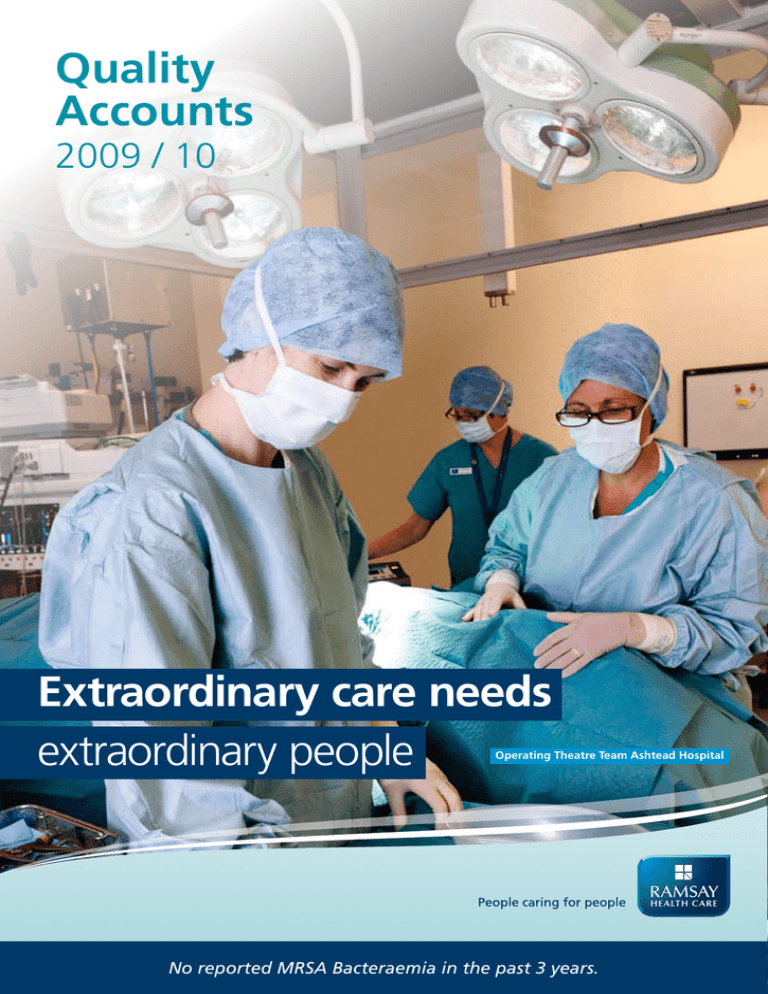
Quality Accounts 2009 / 10 Extraordinary care needs extraordinary people Operating Theatre Team Ashtead Hospital No reported MRSA Bacteraemia in the past 3 years. Part 1 Statement on quality from the Chief Executive Officer Ashtead Hospital Radiology Department P2 Quality Accounts 2009 / 10 Statement of Commitment Chief Executive Officer, Jill Watts This annual report presents Ramsay Health Care’s achievements in terms of clinical excellence, effectiveness, safety and patient experience. Ramsay Health Care UK is committed to establishing an organisational culture that puts the patient at the centre of everything we do. As Chief Executive of Ramsay Health Care UK, I am passionate about ensuring that high quality patient care is at the centre of what we do and how we operate all our facilities. This relies not only on excellent medical and clinical leadership in our hospitals but also upon our overall continuing commitment to drive year on year improvement in clinical outcomes. I believe all healthcare organisations should measure their performance in areas of safety and quality and across all our Ramsay facilities we have a structured clinical governance framework in place that helps us to continually review our performance so we can drive improvements to benefit all patients. Our Quality Account is information for our patients and commissioners to assure them we are committed to sharing our progressive achievements from one year to the next. As a long standing and major provider of healthcare services across the world, Ramsay has a very strong track record as a safe and responsible healthcare provider and we are proud to share our results. Delivering clinical excellence depends on everyone in the organisation. It is not about reliance on one person or a small group of people to be responsible and accountable for our performance. Across Ramsay we nurture the teamwork and professionalism on which excellence in clinical practice depends. We value our people and with every year we set our targets higher, working on every aspect of our service to bring a continuing stream of improvements into our facilities and services. There are inherent risks associated with being a patient in the health care system and it is the professional and legal responsibility of all health professionals and health organisations to ensure that every effort is made to reduce the likelihood and consequence of an adverse event or outcome associated with treatment of a patient. Ramsay UK has adopted a systems approach to risk management. This approach focuses on the systems in place in which the employee works rather than focusing on the acts or omissions of individual employees. Because of the inherent risks associated with being a patient in the health care system a key part of the framework is to ensure that every effort is made to reduce the likelihood and consequence of an adverse event or outcome associated with treatment of a patient. Education plays a key component as employees must feel free to report hazards, near misses, and minor incidents without fear of punitive actions. Ramsay operates to meet long term, not short term healthcare objectives; we invest substantially in our people, our hospitals and in our equipment to ensure consistent high quality care is delivered safely and effectively. Our emphasis is to ensure patients receive safe and effective care, that they feel valued and respected as partners in decisions about their care. Clinicians are enabled to provide that care and our organisation can always satisfy itself that the right things are being done in the right way. To the best of my knowledge, as requested by the regulations governing the publication of this document, the information in this report is accurate. Jill Watts Chief Executive Officer Ramsay Health Care UK Quality Accounts 2009 / 10 P3 Statement of Quality Director Safety and Clinical Performance, Jane Cameron “ We especially value patients’ positive feedback about their experience, clinical treatment and clinical outcome. For example, we actively monitor results of patients’ hip and knee replacement and cataract surgery in the first year after surgery and our patients give us their personal assessments of how their quality of life has improved after surgery. ” Receiving real evidence of patients’ improvement in well-being is immensely satisfying. Patient feedback is also important in informing our clinical teams in their plans for ongoing refinement and improvement to surgical outcomes. We continually measure all aspects of patients’ opinion about their care and treatment and these results, gleaned from face to face discussion as well as short surveys, have been a very important part of our overall business for over 15 years. Over this time we have achieved consistent and high patient satisfaction scores and, by studying results throughout the year, constantly seek ways to further improve patient experience. Ensuring patients are fully informed about their treatment at each step in their care is also a significant factor associated with improving treatment outcomes. We involve our patients in treatment decisions at the earliest stage so that the options and benefits of treatment are fully debated before patients consent to treatment. Our medical and clinical teams devote time to patient preparation for surgery. This not only reduces risk but also improves patient understanding and confidence, reduces anxiety, improves rates of recovery and shortens lengths of hospital stay. So patient feedback and P4 Quality Accounts 2009 / 10 involvement is extremely important but in conjunction with this we also heavily rely upon many other measures of safety and clinical effectiveness; we use these to satisfy ourselves of treatment that is evidence-based, treatment that is delivered by appropriately qualified and experienced doctors and nurses and other key healthcare professionals. Examples of these follow in this Quality Account. Patient safety is our highest priority and we provide sufficient qualified and trained staff to deliver the service in a safe environment. We ensure that our staff are competent through a robust recruitment process and training programmes. We believe it is essential to provide the right person in the right role at the right time to deliver safe and effective treatment and care. Staff are trained on all the equipment they are required to use, and are not allowed to use equipment they have not been trained for and signed off as competent. Ramsay is a long term partner to private medical insurers and to the NHS. For our private patients and NHS patients alike we are committed to meeting and exceeding standards in safety and clinical effectiveness. Our reputation with these organisations depends on a track record of safety and clinical effectiveness. Ramsay is accustomed to the disciplines of regulatory and contractual requirements to assure healthcare commissioners of our clinical performance and to report complaints and serious incidents, where occasionally these occur, to regulators and commissioners. For many years, we have encouraged transparency and a “no blame” culture to embed open reporting of system failures, serious incidents, patient complaints and near misses. We maintain a Risk Register and systematically review specific actions to achieve risk reduction. This discipline extends to a readiness on Ramsay’s part to enable learning across the organisation to support changes to clinical practice and continual improvements to patient safety. In Ramsay the commitment to quality improvement is at every level in the organisation. Jane Cameron Director Safety and Clinical Performance Ramsay Health Care UK Part 2 Quality priorities for 2010 / 11 Time to care - Fitzwilliam Hospital Quality Accounts 2009 / 10 P5 Priorities for improvement Director Safety and Clinical Performance, Jane Cameron Plan for 2010 / 11 “ On an annual cycle, Ramsay develops an operational plan to set objectives for the year ahead. A clear and stated objective is that we aim to be the leader in private health care by providing the highest quality of clinical care and exceed our patients’ expectations. To meet this objective we have set out detailed initiatives to drive safety, clinical effectiveness and improve the patient experience. ” Priorities for improvement “ The priorities are determined by the Executive Management Team on the recommendation of the Clinical Governance, Risk Management and National Medical Advisory Committees. All professional and management levels are represented on these committees. ” 1. Patient safety 2. Clinical effectiveness Barcode for patient identity laserbands Meeting Endoscopy standards In the area of patient safety, we will continue our incremental improvement initiatives to embed safer surgery through bar code enhancement to patient identity Laserbands currently in use. Safer surgery checklists We will undertake further work with specialities such as ophthalmology to add speciality specific enhancements to our Safer Surgery Checklists to support national initiatives to prevent wrong surgery. Cleanliness We plan to maintain our good track record for effective infection prevention and control and to improve ratings in the PEAT (Patient Environment Action Team) assessments. Plans for ongoing investment in refurbishment of our facilities will take advantage of advances in technology and interior design. This will lead to a gain in performance due to better cleaning of new wall surfacing, flooring, ventilation and lighting. P6 Quality Accounts 2009 / 10 This is one of our major priorities for improvement in clinical effectiveness. One of Ramsay’s endoscopy centres was the first independent sector service to successfully complete a Pilot JAG (Joint Advisory Group) accreditation in 2009. In 2010 - 2011 Ramsay will progress work to meet national endoscopy standards through our collaboration with Endoscopy NHS, enrolling all of our participating sites to submit Global Rating Score (GRS) data on to the Endoscopy NHS website to achieve JAG accreditation from 2011. 3. Patient experience Patient feedback has shown that patients attending for day surgery procedures are experiencing a wait from time of arrival of up to or over 2 hours before treatment. Hence the following two initiatives: Investment in day surgery facilities Advances in surgery and anaesthesia have reduced the requirement for an overnight recovery in hospital after a surgical procedure for many patients. In common with other healthcare organisations, Ramsay has seen a marked increase in day patient admissions. Ramsay recognises the opportunity to further improve patient experience for day surgery. Benefits include reduced waits from arrival to treatment, shorter recovery from anaesthetic times and shorter length of stay. In conjunction with the phased refurbishment plans described, Ramsay will invest to reconfigure current day surgery facilities, create additional and superior capacity for patients and create improved flows for better convenience of patients. Releasing time to care The new provision for day patients will, in turn, release nursing time for inpatients where currently nurses manage a greater mix of day patient and inpatient. Releasing additional time for direct nursing care, more time to devote at the bedside with their patients. Ramsay will also extend a current pilot programme of the Productive Ward initiative to generate maximum nursing time with patients. Part 3 Review of quality performance 2009 / 10 Operating Theatre Team Ashtead Hospital Quality Accounts 2009 / 10 P7 Statements of quality delivery Director Safety and Clinical Performance, Jane Cameron Review of quality performance 1st April 2009 - 31st March 2010 Introduction “ Ramsay operates a quality framework to ensure the organisation is accountable for continually improving the quality of their services and safeguarding high standards of care by creating an environment in which excellence in clinical care will flourish. ” Ramsay Clinical Governance Framework 2010 Ramsay is committed to ensuring patient safety and quality of care, and minimising risk. We believe that these are best achieved through strong effective leadership and integrated governance so that there is understanding throughout the organisation that clinical governance is everybody’s business. Our governance supports our quality framework and embraces these key principles: • • • • Clarity about accountability Drivers for improvement, innovation and change Proficiency in financial and human resource management Enablers for organisational learning • • • • Organisational focus on risk management Disciplines in audit and information management Partnerships with stakeholders Investment in training and organisational development This philosophy underpins our business strategy and monitoring of organisational performance enables balanced reviews of business, clinical and safety priorities on an ongoing basis. This quality account has been developed from hospital safety and performance reports for both NHS and private patients used as part of our routine clinical governance and health and safety management across Ramsay. Audit Another quality assurance tool widely deployed by Ramsay is audit. This discipline of periodically assessing a service to test compliance to healthcare standards or safety legislation is of benefit by identifying non-compliant practice. An example of where audit directly benefits patients concerns endoscopy – diagnostic examinations of the upper and lower bowel. In a phased programme across Ramsay, hospitals are involving patients in assessing the endoscopy procedures by means of a Global Rating Scale (GRS). The results assist doctors in refining technique and efficacy of endoscopy and this is helping to drive higher standards in gastroscopy and colonoscopy. Ramsay supports this study and will now work towards accreditation status to qualify Ramsay to participate in national bowel cancer screening. NICE guidance Ramsay also complies with the recommendations contained in technology appraisals issued by the National Institute for Health and Clinical Excellence (NICE). One example is guidance developed to safeguard patients from deep vein thrombosis which can present as a serious post-operative complication of surgery. We have adopted the NICE guidance “Venous Thromboembolism - Reducing the risk of Venous Thromboembolism in Surgery”. Ramsay’s Medical Director, in conjunction with lead clinicians, has developed a corporate policy which gives clear instruction about the necessity to complete a risk assessment for all patients undergoing surgery or those admitted to hospital for other conditions. It provides guidance on treatment options for different conditions and levels of risk. Discussion with the patient and decisions about prophylactic regimen to be used must be documented. Ramsay monitors the number of risk assessments completed and incidence of deep vein thrombosis as an important aspect of patient safety. Ramsay has systems in place for scrutinising all national clinical guidance and for monitoring their implementation. P8 Quality Accounts 2009 / 10 1. Patient safety We are a progressive organisation and focussed on stretching our performance every year and in all performance respects, and certainly in regards to our track record for patient safety. Risks to patient safety come to light through a number of routes including routine audit, complaints, litigation, adverse incident reporting and raising concerns but more routinely from tracking trends in performance indicators. Our focus on patient safety has resulted in a marked improvement in a number of key indicators as illustrated in the graphs below. A network of specialist nurses and infection control link nurses operate across the Ramsay organisation to support good clinical practice. Programmes and activities within Ramsay include: • • • 1.1 Infection prevention and control Ramsay has a very low rate of hospital acquired infection and has had no reported MRSA Bacteraemia in the past 3 years. • Infections as a percentage of admissions • 0.25 0.2 % 0.15 • 0.1 0.05 • 0 2007 2008 2009 Year We comply with mandatory reporting of all Alert organisms including MRSA Bacteraemia and Clostridium Difficile infections with a programme to reduce incidents year on year. Ramsay participates in mandatory surveillance of surgical site infections for orthopaedic joint surgery and these are also monitored. Infection Prevention and Control management is very active in Ramsay. An annual strategy is developed by a high level Infection Prevention and Control (IPC) Committee and group policy is revised and re-deployed every two years. Our IPC programmes are designed to bring about improvements in performance and in practice year on year. Deployment of standard operating procedures, such as hygiene and cleaning procedures, antibiotic prescribing, patient screening protocols (covering medical history and laboratory testing) Reporting includes Surgical Site Infection surveillance and Hospital Acquired Infection data reporting to the Health protection Agency Auditing tracks not only practice compliance as set out in policy / procedures but also tracks risk associated with hand hygiene, peripheral and central venous line / infusions Education of staff operates on a number of different levels – foundation courses for clinical and nonclinical staff, for new starters, as refresher training, as advanced training. Trainers are NHS professionals – specialists practising at consultant level. Patient education is developed in parallel to promote good patient hygiene and to improve understanding of hospital acquired infection. This includes leaflets and website information Patients are invited to comment through patient experience surveys and state perception of standards of cleanliness and staff hygiene behaviours. Ramsay have deployed the PEAT tool to monitor environmental standards and use the NPSA website to trend performance / identify areas for improvement Ramsay has signed up to the National Patient Safety Agency NPSA Clean Hands Campaign where posters and information to staff, patients and visitors encourage and promotes hand hygiene. Hand hygiene practice is audited by observation and also by patient satisfaction survey. Since 2008 we have also delivered a multi-million pound investment in new disinfection, decontamination and sterilisation facilities to process and track surgical instrumentation to meet national decontamination standards. Good infection control practice is also considered at the Ramsay National Procurement Committee in determining procurement strategies. This is an illustration of Quality Accounts 2009 / 10 P9 1.3 Safety in the workplace integrated governance; experiences are shared through joint working of multi-disciplinary teams in our key management committees which is essential in areas such as infection prevention and control. Examples of year on year patient safety initiatives include: Safety hazards in hospitals are diverse ranging from the risk of slip, trip or fall to incidents around sharps and needles. As a result, ensuring our staff have high awareness of safety has been a foundation for our overall risk management programme and this awareness then naturally extends to safeguarding patient safety. Our record in workplace safety as illustrated by Group Accidents per 1000 Admissions demonstrates the results of safety training and local safety initiatives. • Adverse events per thousand admissions Ramsay has systematically implemented patient safety initiatives as part of a programme of targeted risk management across the organisation. • 5 4 1000 • Patient centred pre-operative assessment revised and implemented with training support – delivered in 2008 Preventing wrong site surgery by adopting Safer Surgery Checklist in 2009 Transfusion training for all clinical staff in line with NPSA guidance – delivered in 2009 3 2 1 0 1.2 Cleanliness and hospital hygiene Assessments of safe healthcare environments also include Patient Environment Assessment Team (PEAT) audits. These assessments include rating of privacy and dignity, food and food service, access issues such as signage, bathroom / toilet environments and overall cleanliness. Ramsay scores are improving in these assessments and reflect the investment in our facilities. Plans are in place for further phased investment programme to deliver refurbishments and improvements. These will also support our infection prevention programmes to ensure the fabric of our facilities is optimum for cleaning. 2009 2010 Year Effective and ongoing communication of key safety messages is important in healthcare. Multiple updates relating to drugs and equipment are published every month and we ensure these reach all our teams in a timely way via a Ramsay Central Alert System. Safety alerts, medicine / device recalls and new and revised policies are cascaded electronically to keep each General Manager up to date with safety issues. Every Ramsay hospital has a clinical effectiveness team and committee that meet regularly through the year to monitor quality and effectiveness of care. Clinical incidents, patient and staff feedback are systematically reviewed to determine any trend that requires further analysis or investigation. More importantly, recommendations for action and improvement are presented to hospital management and medical advisory committees to ensure results are visible and tied into actions required by the organisation as a whole. 85.3 85.2 85.1 85 84.9 84.8 84.7 The results highlighted in the graphs demonstrate the effectiveness of this approach over the last three years. 84.6 84.5 84.4 84.3 2007 2008 Year P10 2008 2. Clinical effectiveness Overall cleanliness scores from PEAT assessments % 2007 Quality Accounts 2009 / 10 2009 2.1 Return to theatre Percentage readmissions by year Ramsay is treating significantly higher numbers of patients every year as our services grow. The majority of our patients undergo planned surgical procedures and so monitoring numbers of patients that require a return to theatre for supplementary treatment is an important measure. Every surgical intervention carries a risk of complication so some incidence of returns to theatre is normal. The value of the measurement is to detect trends that emerge in relation to a specific operation or specific surgical team. Ramsay’s rate of return is very low consistent with our track record of successful clinical outcomes. Percentage returns to theatre by year 0.18 0.16 0.14 0.25 0.2 % 0.15 0.1 0.05 0 2007 2008 2009 Year 3. Patient experience Patient satisfaction scores for overall quality show the majority of patients feel they receive excellent quality of care and service in Ramsay facilities. To record a satisfaction index over 90%, a very high proportion of Ramsay’s patients have scored 9 or 10 out of 10 for their satisfaction with all the requirements. This is underlined by comparing Ramsay’s Satisfaction Index against those achieved by other organisations across all sectors of the UK economy where the full range of customer satisfaction is 50% to 95% with the median just below 80%. Ramsay, rated against over 200 service companies in the public and private sector, has consistently been in the top 2-3% of UK organisations in its ability to satisfy customers. 0.12 % 0.3 0.1 0.08 0.06 0.04 0.02 0 2007 2008 2009 Year Patient satisfaction index of over 90% means Ramsay rates in the top 2-3% of organisations 2.2 Readmission to hospital Monitoring rates of readmission to hospital is another valuable measure of clinical effectiveness. As with return to theatre, any emerging trend with specific surgical operation or surgical team in common may identify contributory factors to be addressed. Ramsay rates of readmission remain very low and this, in part, is due to sound clinical practice ensuring patients are not discharged home too early after treatment and are independently mobile, not in severe pain etc. 100 90 80 70 60 % 50 40 30 20 10 0 2008 2009 Q1 2010 Year Quality Accounts 2009 / 10 P11 3. Patient experience (continued) Where specific questions are put to patients, 98% of patients would recommend Ramsay and the same proportion of patients are entirely satisfied with the overall care they received. Over 98% of patients would recommend Ramsay and are entirely satisfied with overall care 100 90 80 % of patients 70 60 50 3.1 Patient Reported Outcome Scores PROMS Average reductions in disability scores over post-operative period Ramsay uses a number of patient reported procedure specific surveys and has been working with patients to collect their responses for over four years since 2006. Currently we collect data about outcomes in joint replacement surgery and cataract surgery. The incremental improvements are benchmarked against published data and Ramsay outcomes have out-performed these. Hip replacement surgery and Knee replacement surgery 40 30 20 10 0 Q1 2009 Q2 2008 Q1 2010 Year Would recommend Ramsay Entirely satisfied with overall care Patient satisfaction with treatment and care from Ramsay medical staff and nurses is high and consistent scores have been achieved. Patient satisfaction with nurses and doctors consistently high Oxford Hip and Knee Questionnaires are used. These are research based validated tools measuring disability – the higher the score the higher the disability. The patient completes the questionnaire before replacement surgery and at a follow up examination and then again at one year following surgery. Hip replacement Oxford Hip Scores - Past 3 years show consistent improvement at follow up (the lower the score the better the outcome) 45 40 35 100 30 90 25 80 20 15 % of patients 70 10 60 5 50 0 2008 40 30 Pre-surgery 1st follow up 1 year 20 10 0 Satisfaction with nurses Q2 2008 P12 Satisfaction with Doctors Q1 2009 Quality Accounts 2009 / 10 Q1 2010 2009 Pre-surgery 1st follow up 1 year Q1 2010 Pre-surgery 1st follow up 1 year Knee replacement Oxford Knee Scores - Past 3 years show consistent improvement at follow up (the lower the score the better the outcome) 45 40 35 30 25 20 15 10 5 0 2008 Pre-surgery 1st follow up 1 year 2009 Pre-surgery 1st follow up 1 year Q1 2010 Pre-surgery 1st follow up 1 year Quality Accounts 2009 / 10 P13 Ramsay Health Care UK Our Facilities 22 Hospitals | 11 Treatment Centres | 3 Neurological Centres The Yorkshire Clinic, Bingley 01274 550600 Cobalt NHS Treatment Centre, Newcastle 0191 2703250 Tees Valley Treatment Centre, Middlesbrough 01642 737 855 Kendal NHS Treatment Centre, Kendal 01539 743000 Clifton Park NHS Treatment Centre, York 01904 464550 Fulwood Hall Hospital, Preston 01772 704111 Euxton Hall Hospital, Chorley 01257 276261 Park Hill Hospital, Doncaster 01302 730300 Oaklands Hospital, Salford 0161 7877700 Gainsborough NHS Treatment Centre, Lincolnshire 01205 591860 Renacres Hospital, Ormskirk 01704 841133 Boston NHS Treatment Centre, Boston 01205 591860 Nottingham Woodthorpe Hospital, Nottingham 0115 920 9209 Rowley Hospital, Stafford 01785 223 203 Woodland Hospital, Kettering 01536 414515 The Westbourne Centre, Birmingham 0121 456 0880 Fitzwilliam Hospital, Peterborough 01733 261717 West Midlands Hospital, Halesowen 01384 560123 Horton NHS Treatment Centre, Banbury 01295 755000 Rivers Hospital, Sawbridgeworth 01279 600282 Gardens Neuro Centre, Sawbridgeworth 01279 600 201 Jacobs Neuro Centre, Sawbridgeworth 01279 600 201 Winfield Hospital, Gloucestershire 01452 331111 The Dean Neuro Centre, Gloucestershire 01452 420 200 Berkshire Independent Hospital, Reading 0118 902 8000 Oaks Hospital, Colchester 01206 752121 Springfield Hospital, Chelmsford 01245 234000 New Hall Hospital, Salisbury 01722 422333 Orwell Private Cardiothoracic Unit 01268 394217 North Downs Hospital, Surrey 01883 348981 Ashtead Hospital, Surrey 01372 221400 Pinehill Hospital, Hitchin 01462 422822 Blakelands NHS Treatment Centre, Milton Keynes 01908 334200 Mount Stuart Hospital, Torquay 01803 313881 Bodmin Treatment Centre, Bodmin 01208 262520 Duchy Hospital, Truro 01872 226100 For further information please contact: 020 7847 2850 www.ramsayhealth.co.uk


